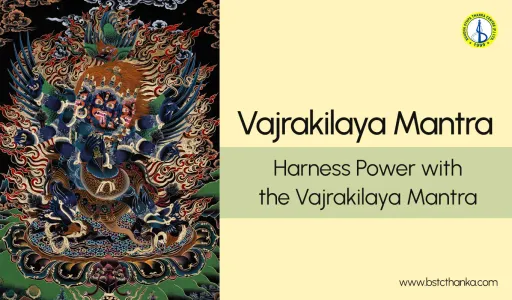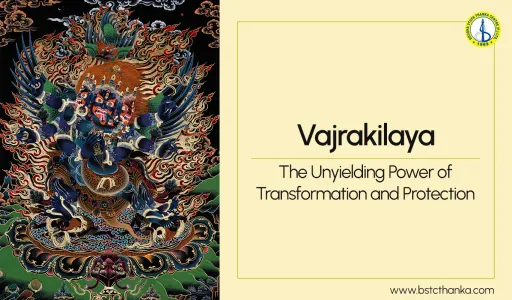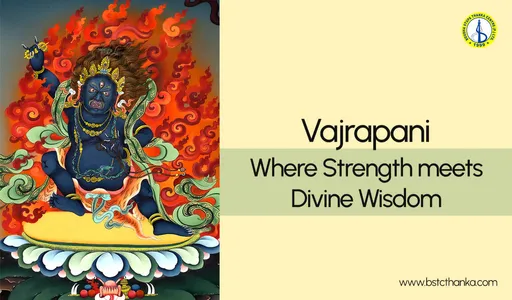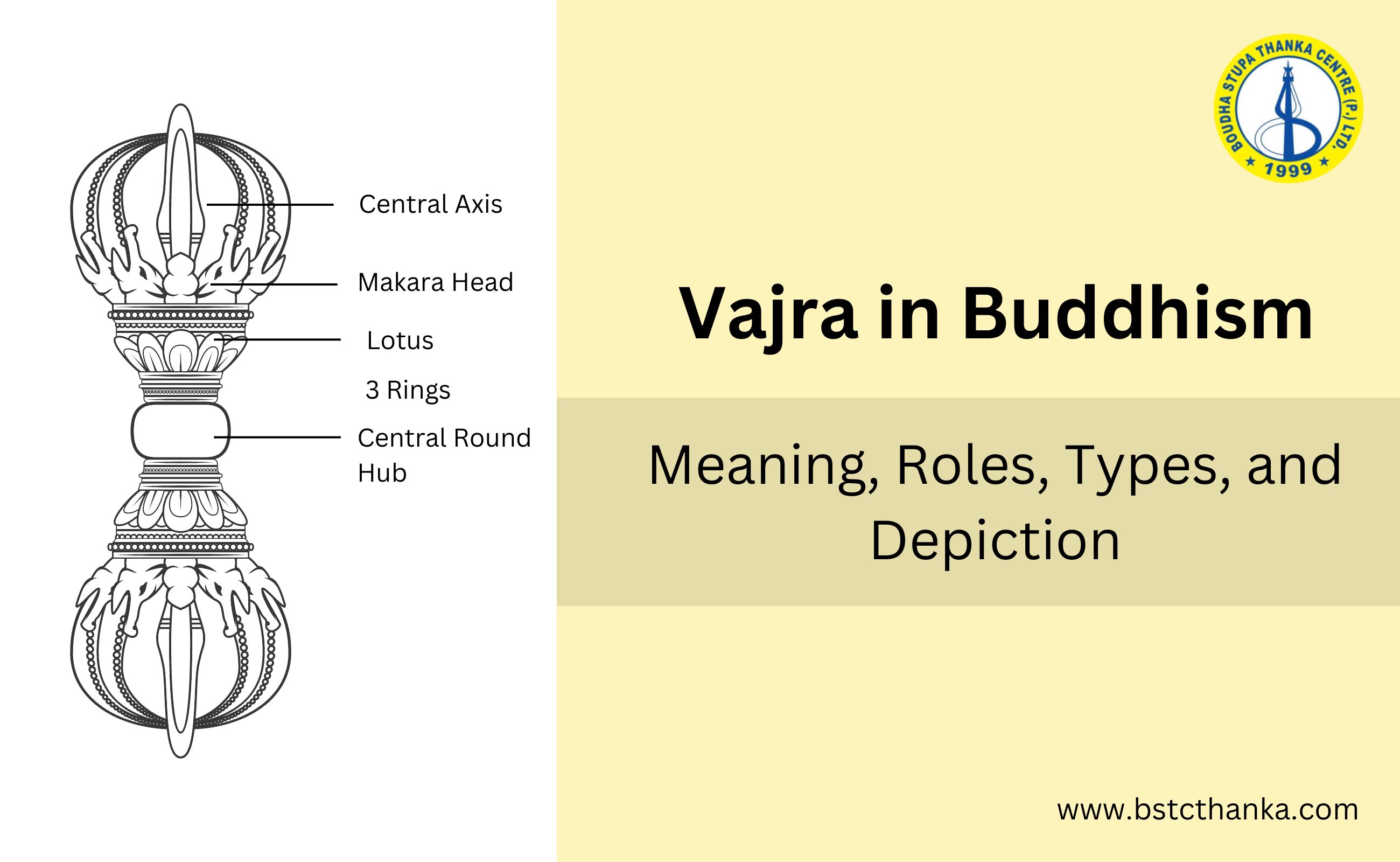
Vajra in Vajrayana Buddhism: Meaning, Roles, & Types
What is a Vajra in Buddhism?
Vajra or Dorje is a significant symbol and ritual tool in Vajrayana Buddhism (also known as Tantric or Esoteric Buddhism) which means “Diamond Thunderbolt” symbolizing the qualities of indestructibility, power, and spiritual strength. The Vajra is important in rituals and teachings, representing the combination of wisdom and compassion. This guide explores the deep meanings, different types, and cultural importance of the Vajra, showing its key role in Buddhist art and spiritual practice.
Vajra symbolizes the properties of a diamond (indestructibility) and a thunderbolt (irresistible force) signifying both the indestructible nature of truth and the irresistible force of enlightenment. Traditionally, vajra is a ritual implement shaped like a scepter, often depicted with two heads or prongs at either end, symbolizing the union of opposites. Rooted in ancient Indian traditions, the Vajra transcends mere symbolism, serving as a potent tool for spiritual transformation in Vajrayana practices. Its anatomy is rich with symbolic meaning:
Symbolism of Vajra in Different Culture
The symbolism of Vajra varies across traditions, particularly in Hinduism and Tantric Buddhism.
Symbolism of Vajra in Hinduism
In Hindu mythology, the vajra is primarily associated with Indra, the king of the gods and deity of thunder and lightning. Known as "vajrayudha" (thunderbolt weapon), it represents Indra's supreme power and authority over the celestial realm. The vajra symbolizes indestructibility, irresistible force, and divine power.
Hindu text Rigveda describes the vajra as forged from the bones of sage Dadhichi, who sacrificed himself for the greater good. This origin story imbues the vajra with additional symbolism of selflessness and spiritual strength. In iconography, several Hindu deities are depicted wielding the vajra, emphasizing their divine power and ability to vanquish evil.
Symbolism of Vajra in Tantric Buddhism
In Tantric rituals, the vajra is often paired with a bell (ghanta), representing the feminine principle. The practitioner holds the vajra in the right hand and the bell in the left, symbolizing the union of method (upaya) and wisdom (prajna) – key concepts in Tantric philosophy.
Anatomy of Vajra
Central Axis (Yug) and Center (Bindu): The Vajra typically features a central axis or stem, known as the Yug. At the center of this axis is the Bindu, a focal point symbolizing the unity of wisdom and compassion, the essence of enlightenment.
Prongs (Dant) or Blades: Extending from the central axis are the prongs or blades, usually four or five on each end. These prongs are often depicted as sharp, pointed elements. The number of prongs can vary, with each representing different aspects of spiritual energy. For instance:
Lotus Base: The central axis of the Vajra is often supported by a lotus base. This base symbolizes purity and the unfolding of spiritual potential, indicating that enlightenment arises from the purity of the practitioner's mind.
Bell (Ghanta): In many depictions, the Vajra is paired with a bell, symbolizing the union of wisdom (bell) and method (Vajra). The bell represents the feminine principle, the resonance of emptiness, while the Vajra represents the masculine principle, the power of form.
Decorative Elements: The Vajra may be adorned with intricate carvings or decorations, such as dragon heads or intricate patterns, which signify various aspects of divine power and protection.
Types and Meaning of Vajra in Vajrayana Buddhism
In Vajrayana Buddhism, the Vajra comes in various forms, each with its unique symbolism and spiritual significance. Mainly 6 different Vajras are found in Buddhism; one pronged, two pronged, three pronged, four pronged, five pronged, and nine pronged Vajras. Among them five and nine pronged Vajra are more common.
The different types of Vajras are not just symbolic objects; they represent various aspects of the enlightened mind and serve specific purposes in rituals and meditation practices. A detailed view of types of Vajra along with meaning and depiction as different aids is given below.
Single Pronged Vajra
The Single Pronged Vajra is a less common but deeply significant form of the Vajra. This version of the Vajra symbolizes unity and the singular focus of the mind in meditation. It represents the unification of dualities, such as wisdom and compassion, into one inseparable force.
In practice, the Single Pronged Vajra is often used in rituals that emphasize the integration of these qualities, guiding practitioners towards a state of oneness and clarity. Its straightforward design reflects the simplicity and directness of the enlightened state it represents.
Three Pronged Vajra
The Three Pronged Vajra, also known as the Trishula Vajra, is a symbolic tool representing the three key aspects of enlightenment in Vajrayana Buddhism: body, speech, and mind.
These three prongs signify the transformation of ordinary physical actions, words, and thoughts into pure, enlightened expressions.
In rituals, the Three Pronged Vajra is often used to help practitioners purify these three aspects, aligning them with the path to enlightenment.
The central prong symbolizes the ultimate truth, while the two side prongs represent compassion and wisdom, all converging to lead one toward spiritual awakening.
This Vajra’s design serves as a reminder of the need to balance these elements in daily practice, helping individuals cultivate a more harmonious and enlightened state of being.
Five Pronged Vajra
The Five Pronged Vajra is one of the most commonly used forms in Vajrayana Buddhism. Each of its five prongs symbolizes one of the Five Wisdoms, which are the enlightened aspects of consciousness: the Wisdom of Emptiness, the Mirror-like Wisdom, the Wisdom of Equality, the Discriminating Wisdom, and the All-Accomplishing Wisdom.
In practice, the Five Pronged Vajra represents the transformation of negative emotions into these positive, enlightened qualities. For example, anger is transformed into the Mirror-like Wisdom, which reflects reality without distortion.
The central prong of the 5-pronged Vajra symbolizes the unity of these wisdoms, showing how they all come together in the mind of an enlightened being.
Nine Pronged Vajra
The Nine Pronged Vajra is a powerful symbol in Vajrayana Buddhism, representing the culmination of spiritual practice. Each of the nine prongs signifies one of the Nine Yanas, or spiritual paths, that lead to enlightenment. These paths range from foundational teachings to advanced tantric practices, guiding practitioners through different stages of spiritual growth.
In addition to representing the Nine Yanas, the Nine Pronged Vajra also symbolizes the ultimate realization of the nine qualities of the Buddha's wisdom and compassion. This Vajra’s design emphasizes the interconnectedness of these paths and qualities, showing how they converge in the state of full enlightenment.
VishvaVajra: Crossed Vajra
The VishvaVajra, also known as the Crossed Vajra or Double Dorje or Universal Vajra, is a prominent ritual object in Vajrayana Buddhism, symbolizing the union of wisdom and compassion. It consists of two Vajras (thunderbolts) crossed at their centers, representing the merging of dualistic concepts.
This design underscores the inseparable nature of the ultimate reality, transcending binary distinctions. The VishvaVajra embodies the transformative power to dispel ignorance and obstacles, while also signifying the dynamic interplay of the male and female energies in the cosmic dance of creation and dissolution.
The VishvaVajra serves as a potent symbol of spiritual enlightenment and integration.
Depiction of Vajra in Thangka
In Thangka art, the Vajra is a prominent symbol, intricately depicted to convey deep spiritual meanings and its association with various deities. In traditional thangkas, the Vajra is often depicted as a ritual object with a central shaft and symmetrical prongs at both ends. The prongs are usually adorned with lotus motifs and can vary in number—typically four, five, or nine—each with its own symbolic significance.
The Vajra is frequently shown in the hands of deities, embodying their power and authority. For instance, Vajrapani, the fierce protector of the Buddha's teachings, is commonly depicted wielding the Vajra to represent his power to overcome ignorance and obstacles.
Similarly, Vajrasattva, associated with purification, holds the Vajra as a tool for cleansing defilements and restoring purity. The detailed representation of the Vajra in Thangkas often includes elaborate patterns and additional symbols, such as dragons or flames, reflecting its divine attributes and protective qualities.
Depiction of Deities With Vajra in Thangka
In Thangka art, several key Buddhist deities are depicted with the Vajra, each using it in unique ways that reflect their specific qualities and roles. The following deities of buddhism have been depicted with Vajra:



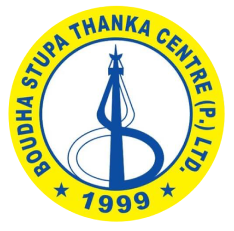
.webp)
.webp)
